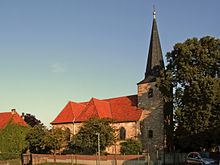St. Vitus (Gross Giesen)
St. Vitus is a Roman Catholic parish church in the Giesen community in the Hildesheim district in Lower Saxony . Your parish of the same name belongs to the deanery Borsum-Sarstedt of the diocese of Hildesheim .
history
In a document from the Mauritian monastery from 1147, Groß Giesen is named Jesen . Other place names in the 12th to 13th centuries were superiori jesen , Gesen , Gesim and Echt Gysen .
In 1235, the church , which was probably built as a noble's own church , was transferred to the Godehardikloster by Knight Dietrich von Depenau . The right of patronage therefore belonged to the Benedictine monastery , which was ultimately responsible only to the Grand Forester Archdeacon ( iudex ordinarius ) in exercising its rights . A pastor was previously confirmed in a document for the year 1227. When the Godehardikloster was in economic difficulties in the 14th century, it turned to Pope Martin V with a request to take over the parish and church in Groß Giesen , who granted the request in 1424. With the papal encouragement through the incorporatio quod temporalia et spiritualia , the monastery fathers looked after the parish office there. Despite the St. Vitus - Patroziniums the construction of the church can not be accurately determined. The veneration of Saint Vitus in the Diocese of Hildesheim had already begun after his relics had been handed over from Saint Denis to the Corvey Monastery in 836 . Since the establishment of a private church under the spell of Förste by the nobility as competition to the episcopal archdeaconate church of St. Pankratius cannot be ruled out, the time when the church was built in the 12th to 13th centuries can only be assumed. The parish of St. Vitus enclosed probably date from the 16th century, the villages Klein Beelte and United Beelte To commemorate this probably during the Hildesheimer pin feud defunct or earlier localities, 1929 patrociniums of were St. Nicholas in United Beelte and St Bernward in Klein Beelte taken over as a subsidiary patron of the Groß Giesener St. Vitus Church.
During the reign of Hildesheim Bishop Friedrich von Holstein , who was sympathetic to the Reformation , the pastor's position was filled with an evangelical preacher from the tax forest office . After Burchard von Oberg became Bishop of Hildesheim, he tried to rebuild the Catholic faith in the parishes of the Tax Forest Office. The fact that the evangelical clergyman was still allowed to stay in the parish until 1571 was probably due to the disregard of the episcopal ordinance by the bailiff of the Steuerwald family. For the year 1573 a Catholic pastor is confirmed again. New changes in the occupation of the pastor's office occurred during the Swedish occupation of the monastery area , in which two Protestant clergy cared for Groß Giesen. During the Thirty Years War , the parish church of St. Vitus was probably badly damaged or destroyed. It was rebuilt from 1672 to 1675. In 1929 an extension followed. From 1973 to 1975 the church was renovated and redesigned after the Second Vatican Council .
The development of the parish has been clearly structured since the Middle Ages . As far back as the 12th century, St. Vitus was demonstrably part of the Förste archdeaconate and, according to today's understanding, owned the rights of a parish . With the circle order of the Diocese of Hildesheim, the parish remained in the forester circle in 1760. When the diocese was given a new structure in 1838 through its deanery division , it remained in the Förste deanery. In 2014 Giesen was assigned to the new Borsum-Sarstedt Dean's Office.
On November 1, 2014, the parish of St. Vitus was established with its seat in Giesen, to which the subsidiary churches St. Martin in Klein Giesen, St. Pankratius in Groß Förste, St. Johannes Baptist in Klein Förste, St. Andreas in Hasede, St Maria and St. Peter and Paul belong in Ahrbergen. Parish church is St. Vitus in Groß Giesen.
architecture
Medieval quarry stone building with six ceiling paintings from around 1675 and a high altar from the early 18th century.
literature
- Municipality of Giesen (ed.): Giesen - a chronicle in pictures. Horb am Neckar 1990
- GIESEN. GROSS-GIESEN district. Catholic Church of St. Vitus. In: Georg Dehio : Handbook of German Art Monuments . Bremen Lower Saxony. Deutscher Kunstverlag, Munich / Berlin 1992, ISBN 3-422-03022-0 , p. 496.
Web links
Individual evidence
- ↑ Bischöfliches Generalvikariat Hildesheim (ed.): Handbook of the Diocese of Hildesheim, Part 1 - Region Hildesheim , p. 236, self-published, Hildesheim 1992
- ↑ Bischöfliches Generalvikariat Hildesheim (ed.): Handbook of the Diocese of Hildesheim, Part 1 - Region Hildesheim , pp. 236–237, self-published, Hildesheim 1992
- ↑ Bischöfliches Generalvikariat Hildesheim (ed.): Handbook of the Diocese of Hildesheim, Part 1 - Region Hildesheim , p. 237, self-published, Hildesheim 1992
- ↑ Bischöfliches Generalvikariat Hildesheim (Ed.): Kirchlicher Anzeiger. No. 8/2014, pp. 215-218
Coordinates: 52 ° 11 '54.9 " N , 9 ° 53' 39.5" E
